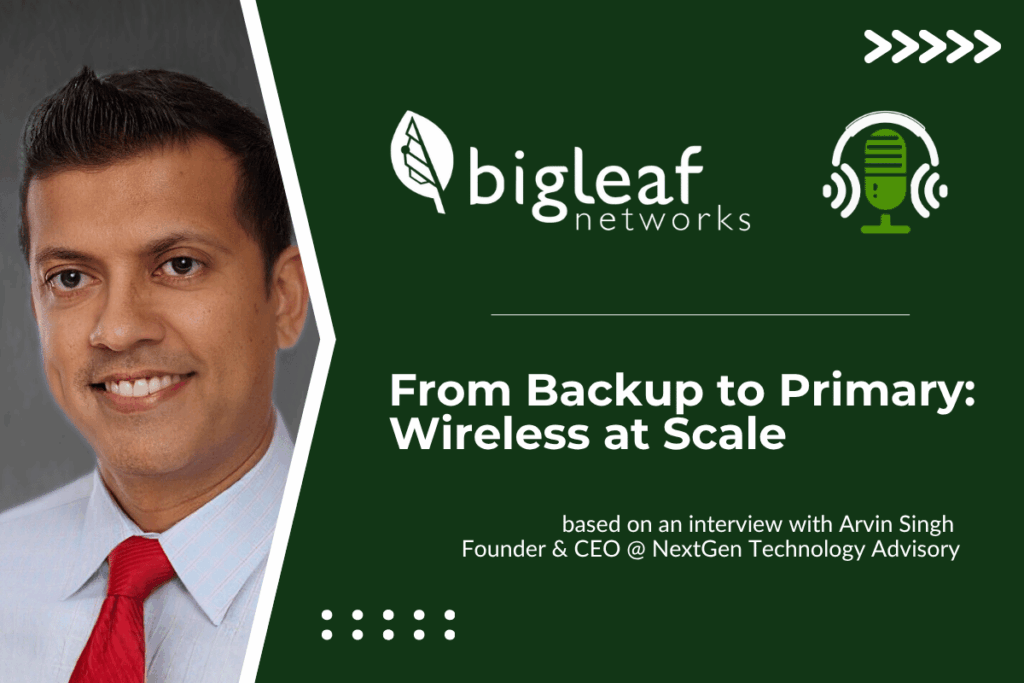Wireless Grows Up
Wireless networks are no longer the fallback option—they’ve become the foundation for growth.
In this episode of Go Beyond the Connection, Arvin Singh explains how 5G capacity, SD-WAN architecture, and multi-carrier design have transformed wireless into a primary business connection for enterprises of every size.
After spending two decades at Verizon leading 5G and edge innovation, Arvin now advises startups and global operators through NextGen Technology Advisory. He’s seen first-hand how enterprises moved from testing wireless failover to launching entire branches and retail sites on wireless-first deployments.
The Tipping Point for Wireless
“There was a time in our history when wireless was used mainly as backup connectivity to wired circuits,” Arvin recalls. “But now, with telecom infrastructure built on ubiquitous nationwide 4G and 5G networks, there is ample capacity, spectrum, and access.”
That capacity shift unlocked entirely new design possibilities. Fiber remains powerful, but its reach and installation times can’t keep up with market demands. Wireless fills the gap—delivering day-one connectivity that scales as businesses grow.
Key Takeaways
- 5G coverage and spectrum make wireless a primary path, not a backup.
- SD-WAN adds application-aware routing and performance stability.
- Multi-carrier options ensure resilience during outages or maintenance.
- Wireless deployments cut time to market from months to days.
Why SD-WAN Changed Everything
The shift to wireless-first didn’t happen by radio alone. SD-WAN gave IT leaders the confidence to trust wireless for critical workloads. By dynamically selecting the best path for each application, SD-WAN minimizes downtime and maximizes throughput. As Arvin puts it, “Solutions like SD-WAN give you peace of mind about network path optimization, application performance, and prioritization.”
In practice, that means video calls stay smooth when traffic spikes, POS transactions run without timeouts, and cloud apps stay responsive no matter which carrier experiences a dip in signal quality.
Wireless deployments also simplify rollouts for new locations. Instead of waiting for construction crews to pull cables, IT teams drop in a preconfigured 5G gateway, power it on, and connect within minutes. When every week counts toward revenue recognition, that speed is a strategic advantage.
Real-World Proof Points
Before leaving Verizon, Arvin saw hundreds of thousands of business sites go live on wireless as their primary connection. That kind of scale only happens when results are repeatable. Performance data showed consistent throughput and uptime comparable to wired lines—often with less complex support and better visibility through SD-WAN dashboards.
Arvin encourages leaders to look beyond cost savings and see the business impact. Faster deployments mean stores and branches open on schedule. More resilient networks keep revenue-producing apps online during carrier events. Lower complexity frees IT time for innovation instead of firefighting.
Start with a Pilot
Enterprises don’t have to go all in at once. The smart move is to run a pilot with real production traffic and track key metrics: latency, session stability, time to turn up, and failover response. Use those findings to justify broader adoption and budget alignment.
As Arvin puts it, “It doesn’t happen by accident. It just speaks to the high-quality networks that service providers are building these days.”
The data backs him up—modern wireless networks are proving reliability at scale and rewriting how enterprises think about connectivity.
Wireless has graduated from backup to business backbone. It shortens deployment cycles, adds resilience, and keeps applications stable under load. The companies that embrace it first gain speed and flexibility their competitors can’t match.
As Arvin Singh says, “The road to wireless is one where you can’t be a spectator of the game.”
For organizations ready to compete faster and deploy smarter, wireless-first is the way forward.
Related Articles
- Why Businesses Rely on a Wireless-First Infrastructure
- Wireless-First Infrastructure Explained: Lessons from Arvin Singh
- From Backup to Primary: Wireless at Scale
- How Wireless Connectivity Drives Business Growth
- Watch the YouTube Playlist of video episodes
- Watch the YouTube Shorts Playlist
- Subscribe to the LinkedIn Newsletter
- Listen on Captivate: Go Beyond the Connection
- Follow us on social: Linkedin | Facebook | Instagram
- Learn how Bigleaf Wireless Connect supports multi-carrier SD-WAN for resilient deployments.
